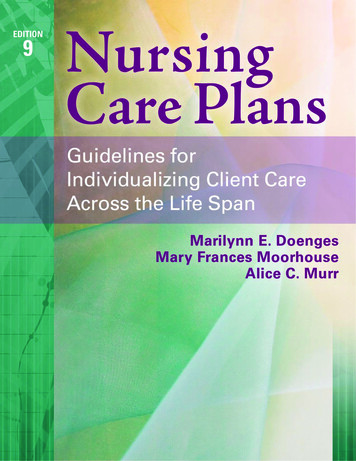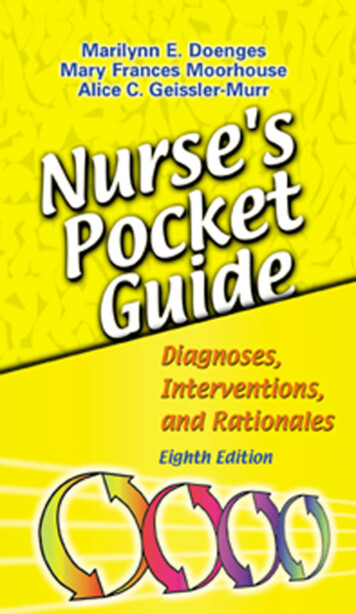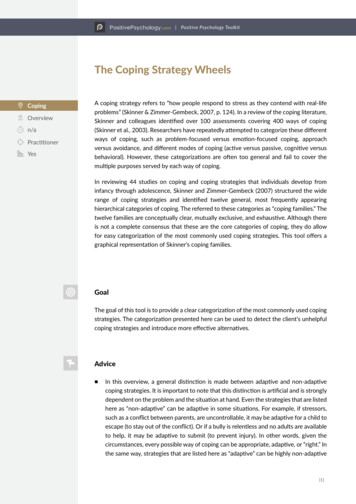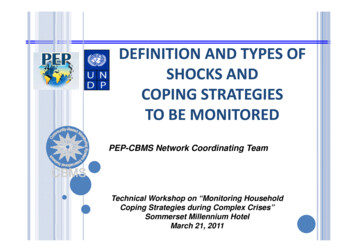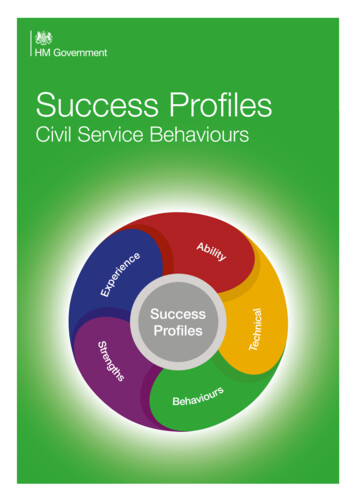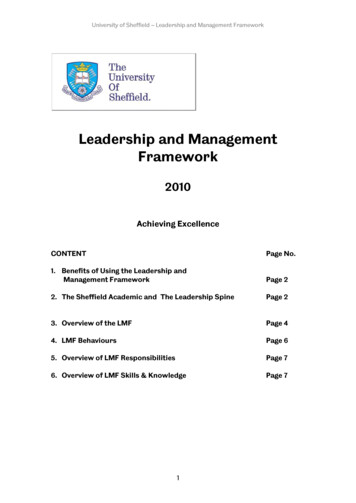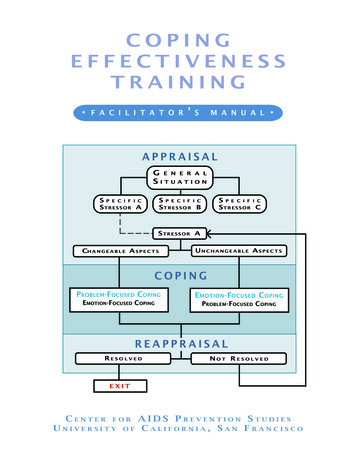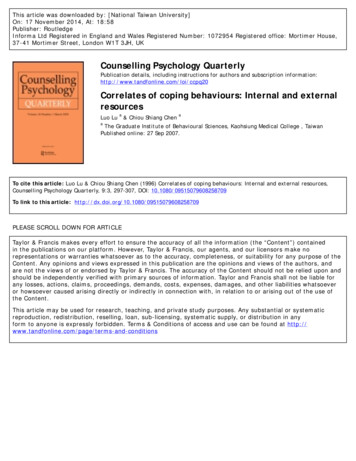
Transcription
This article was downloaded by: [National Taiwan University]On: 17 November 2014, At: 18:58Publisher: RoutledgeInforma Ltd Registered in England and Wales Registered Number: 1072954 Registered office: Mortimer House,37-41 Mortimer Street, London W1T 3JH, UKCounselling Psychology QuarterlyPublication details, including instructions for authors and subscription orrelates of coping behaviours: Internal and externalresourcesaLuo Lu & Chiou Shiang ChenaaThe Graduate Institute of Behavioural Sciences, Kaohsiung Medical College , TaiwanPublished online: 27 Sep 2007.To cite this article: Luo Lu & Chiou Shiang Chen (1996) Correlates of coping behaviours: Internal and external resources,Counselling Psychology Quarterly, 9:3, 297-307, DOI: 10.1080/09515079608258709To link to this article: http://dx.doi.org/10.1080/09515079608258709PLEASE SCROLL DOWN FOR ARTICLETaylor & Francis makes every effort to ensure the accuracy of all the information (the “Content”) containedin the publications on our platform. However, Taylor & Francis, our agents, and our licensors make norepresentations or warranties whatsoever as to the accuracy, completeness, or suitability for any purpose of theContent. Any opinions and views expressed in this publication are the opinions and views of the authors, andare not the views of or endorsed by Taylor & Francis. The accuracy of the Content should not be relied upon andshould be independently verified with primary sources of information. Taylor and Francis shall not be liable forany losses, actions, claims, proceedings, demands, costs, expenses, damages, and other liabilities whatsoeveror howsoever caused arising directly or indirectly in connection with, in relation to or arising out of the use ofthe Content.This article may be used for research, teaching, and private study purposes. Any substantial or systematicreproduction, redistribution, reselling, loan, sub-licensing, systematic supply, or distribution in anyform to anyone is expressly forbidden. Terms & Conditions of access and use can be found at ns
Counselling Psychology Quarterly, Vol. 9, No. 3, 1996, pp. 297-307RESEARCH REPORTCorrelates of coping behaviours:internal and external resourcesLUO LU & CHIOU SHIANG CHENDownloaded by [National Taiwan University] at 18:58 17 November 2014The Graduate Institute of Behavioural Sciences, Kaohsiung Medical College, TaiwanThis study examined some possible factors that were expected to influence choices ofcoping strategies. They were demographic variables (age, sex, marital status, education, and familyincome), personality traits (extravmion, neuroticism and locus of control), perceived life stress, andreceived social support. Five hundred and eighty one randomly selected community adults living inKaohsiung city were interviewed and completed questionnaires measuring the above variables.Multivariate analyses had shown that: (a) higher income and education were related to more use of‘Seeking social resources’ and ‘Planning & hoping’ coping; (b) higher extraversion was relared tomore use of ‘Seeking social resources’, ‘Planning & hoping’ and ‘Emotional suppression’ coping,whereas the last was also related to higher neuroticism; (c) people with higher internal locus of controlfavoured ‘Planning 0 hoping: but not ‘Emotional suppression’ coping; (d) perceived life stress wasnot related to any use of coping behaviours; however, (e) more social support was related to more useof all kinds of coping behaviours. Implications of results were discussed in the context of stress andadaptation,ABSTRACTIntroductionCoping is an an important part of the stress process. It is usually viewed as acomplex set of processes that may moderate influences of stressful life events on theindividual’s physical and mental health (Billings & MOOS,1981; Folkman et al.,1986; Lu, 199 1; Lazarus, 1993). However, most studies in the literature are devotedto examine the impact of coping behaviours on physical and psychologicalwell-being, or to develop a general typology of coping behaviours. Fewer studieshave actually investigated various factors that may affect the use of different copingstrategres. Therefore, this study will examine multiple correlates of copingbehaviours in the hope that this will generate a fuller understanding of stress andmental health.A review of the literature on general human adaptation indicates that manyfactors may play important roles in contributing to an individual’s choice of copingbehaviours. These factors include age period (Folkman et al., 1987), type of stressfulevents (Lazarus & Launier, 1978), cognitive appraisal of stressful events (FolkmanCorrespondence: Professor Luo Lu, The Graduate Institute of Behavioural Sciences, KaohsiungMedical College, 100 Shh-Chuan 1 st Road, Kaohsiung, Taiwan.0951-5070/96/030297-11 0 Journals Oxford Lrd
Downloaded by [National Taiwan University] at 18:58 17 November 2014298 Luo Lu & Chiou Shiang Chen& Lazarus, 1985; Thoits, 1991), personality traits (Carver et al., 1989; Lu, 1991),level of life stress (Lu, 1991), and social support (Holahan & MOOS, 1987;Fondacaro & Moos, 1987; Thoits, 1986).Evidence for the relationship between age and coping is mixed. Some researchhas found that late adulthood is characterized by adaptive coping behaviours (Inon& Blanchard-Fields, 1987); some research has found that younger people use moreadaptive coping (Folkman et d., 1987); still, other research has found little or no agedifferences in coping behaviours (McCrae, 1989).One way to reconcile this research discrepancy is to look at the issue of adaptivecoping in more detail. Although most researchers agree that the efficacy of aparticular coping strategy should be evaluated against a variety of criteria (cf. Taylor,1995), in practice, it is still often implied that active coping behaviours such asproblem-solving, seeking social support are ‘adaptive’, whereas suppression copingsuch as denial, distancing are ‘maladaptive’. On the other hand, researchers havelong asserted that types of stressful events may influence people’s choice of copingstrategies (Lazarus & Launier, 1978). In one study it was found that work-relatedproblems most commonly led people to attempt active coping, whereas healthproblems, in contrast, led to more emotion-focused coping. Since younger peopleencounter more work-related and family-related problems, in which somethingconstructive can be done, it is conceivable that they will favour active coping; by thesame token, since older people encounter more health problems which must beaccepted or got used to, they will favour suppression (Forsythe & Compas, 1987;Shieh, 1994). It seems that adaptive coping should be reconceptualized to reflect thenature of a particular situation or event which activated coping in the first place. Italso seems that age, probably through different natures of life situations associatedwith it, does bear a certain relationship with preference of different copingbehaviours.On another front, general personality traits may also influence personal copingstyles. Parkes (1986) has found that extroverts tend to use more direct copingstrategies than introverts. Internal locus of control has been found to correlate withdirect coping too (Parkes, 1984; Lu, 1991). Neuroticism measured by trait anxietyhas also been found to relate to maladaptive coping (Parasuraman & Cleek, 1984).However, some researchers maintain that personality traits are not significantpredictors of coping behaviour (Cohen & Lazarus, 1973).It is very unlikely though, that personality traits would have (or not have) simplelinear relationships with coping behaviours as suggested by the above mentionedstudies. Unfortunately, relatively few investigations have examined these factorssystematically as potential moderators of the stress-coping relationships. However,evidence of their impacts on stress outcome is unequivocal, particularly thoseinvolving locus of control (or perceived control) and neuroticism (or negativeaffectivity) (e.g. Watson & Clark, 1984; Brett er al., 1990; Lu, 1994). Despitecautions and insufficient evidence, the preceding conjectures raise the possibilitythat there is a health-prone personality, characterized by a sense of control,extraversion and lack of neuroticism. Furthermore, this health-prone personality canact as a reservoir of ‘personal resources’ or ‘internal resources’ in time of stress, to
Downloaded by [National Taiwan University] at 18:58 17 November 2014Correlates of coping299facilitate effective coping. Therefore, looking more specifically at the relationshipbetween personality characteristics and coping behaviours is a worthwhile goal forstudy.However, coping is not only influenced by the internal resources an individualhas but also by external resources available to himiher. Social support is perhaps avery important factor in this respect. So far the major focus on social supportresearch has been to demonstrate links between adaptation and varied levels ofsocial support (Cohen & Wills, 1985). However, recent work (Fondacaro L? MOOS,1987) has pointed out the plausibility of social support as a determinant of coping.Thoits (1986) also stressed the importance of social support as a coping assistance.More promisingly, a recent study (Valentiner et d., 1994) adopting a prospectivedesign has confirmed that parental support available to college students determinedtheir use of ‘approach coping’ (a term exchangeable with active coping). It seemsdesirable to replicate and extend this empirical relationship, by examining a widerrange of social support in a general population.Finally, studies on factors affecting the coping behaviours have usuallyexamined the relationship between a single variable and coping, without consideringeffects of other relevant factors. Therefore, this present study will adopt amultivariate approach to examine the following hypotheses: (1) demographicvariables (age, sex, marital status, education, and income) are related to copingbehaviours; (2) personality traits (extraversion, neuroticism and locus of control) arerelated to coping behaviours; (3)perceived life stress is related to coping behaviours;(4) received social support is related to coping behaviours. Ideally, these hypothesesshould be more specific in direction, however, due to insufficient existing evidence,it will be treated as an empirical problem.MethodsSubjectsUsing multi-stage cluster sampling with probability proportionate to size, 600 adults aged over 20 livingin Kaoshung city were randomly selected, covering downtown districts, industrial dismcts, andsuburban dismcts. According to the published national census data, the final sample of 581 subjectswere fairly representative of the city’s population in terms of major demographc variables, such as sex,age, education attainment, and family income. All subjects were interviewed at their homes duringJuly-September 1993.MeasurementsThe questionnaires had five parts, described below.Demographu informanon. Subjects’ age, sex, marital status, education attainment, and family incomewere recorded.Personaliry truirr. Extraversion and neuroticism were measured by the E and N scales in the EPQ(Eysenck & Eysenck, 1975), which is one of the most often used measurements for the target personalitytraits, and has demonstrated good cross-cultural validity. Locus of control was measured by the revisedSphere of Conuol Inventory (Paulhus, 1983), covering personal efficacy and interpersonal control. T h e
300 Luo Lu & Chwu Shiang ChenChinese version had a Cronbach alpha of 0.90 and good validity (Lu, 1994). In all the three cases,hgher scores indicated more manifested corresponding personality traits. In the case of locus of control,it scored in the ‘internal’ direction.Downloaded by [National Taiwan University] at 18:58 17 November 2014Perceiued lif.e srress. Based on the Social Readjustment Rating Scale (Holmes & Rahe, 1967), andadding some culturally specific events (such as military conscription), a total of 41 events were listed inthe final Life Events Scale. Subjects were required to rate the perceived severity of each event whichhappened in the past year on a 3-point scale, and the total severity score was computed to represent levelof life stress.Social suppon. Actual received support was measured by Socially Suppomve Behaviours (Barrera etul., 1981), which included tangible, emotionakompanionshp, and informational support. Higherscores indicated higher levels of received support.Coping behaviours. Ways of Coping Checklist (WOCC) (Lazarus & Folkman, 1984) is probably themost popular measure in coping research. Folkman, Lazarus and their colleagues (Folkman et al., 1986)originally identified eight different coping strategies using 85 married California couples. These were‘confrontative coping’, ‘seeking social support’, ‘ p l d problem solving’, ‘self control’, ‘distancing’,‘positive reappraisal’, ‘accepting responsibility’, and ‘escapdavoidqnce’. Many subsequent studies haveused WOCC, and came up with various factorial structures (e.g. Pearlin & Schooler, 1978; Parkes,1984). In general, the Parkes’ two-factor structure representing direct coping and suppression is thesimplest and most economic in the sense that it used only 33 items, yet covered all of the eight originalsubscales. Therefore, this short version of the WOCC was used to measure coping behaviours. However,to guard against the possibility of factorial changes due to sample differences, a factor analysis usingprinciple components techniqueewas conducted with the present sample. After varimax rotation, wefound four factors with eigenvalues 1, and the scree plot also indicated that such a four-factor solutioncould best fit the data. For clarity of presentation, items grouped under a particular factor in Table I allhad loadings 0.30. Whenever there was a item loaded on more than one factor, a judgment of choicewas made to achieve maximum internal coherence within a factor. As we can see, the original directcoping items (Parkes, 1984) were further split into two factors as ‘seeking social resources’ and ‘planning& hoping’; similarly, the original suppression items were further split into two factors as ‘emotionalsuppression’ and ‘cognitive suppression’. Cronbach alpha coefficient for each factor was high, and43.1% of the total variance could be explained. Scores of these four factors were then used in lateranalyses.ResultsDescriptive analyses were f i s t conducted to illustrate the sample demographiccharacteristics, and as mentioned before, the sample was a fairly representativecommunity group. Results are presented in Table 11.Pearson correlation coefficients were computed among all variables studied.Results are presented in Table 111. For simplicity sake, we will focus on correlationsinvolving the four kinds of coping behaviours only. First, more ‘seeking socialresources’ and ‘planning & hoping’ coping were used by younger, better educated,and wealthier people; by people who were higher on extraversion and internal locusof control; by people who received more social support. Second, more ‘Emotionalsuppression’ coping was used by younger and not married people; by people whowere higher on extraversion and lower on internal locus of control; by people whoperceived more life stress; by people who received more social support. Finally, onlyfemales used more ‘cognitive suppression’ coping.
Cowelates of coping 301TAB I. Factor loadings on 'ways of coping checklist'Downloaded by [National Taiwan University] at 18:58 17 November 2014ItemsSeeking socialresourcesAsk for adviceGet professional helpTalk to someoneFind out more about the situationTalk to someone about your feelingsGo over the problemConcentrate on something goodDouble your effomChange somethingConcentrate on next stepTake things one step at a timeWish you were a stronger personStand your groundMake a planWish. . . would go awayDaydreamHave fantasiesFeel badHope a miracleWish. . . could change the feelingsLet your feelings outBlame yourselfWish. . . could changeTake it outEating, drinking, smoking, drugs. . .Believe fatalismGo on livingNot let it bother youMake light of the situationThe next best thingTime will make a differenceRefuse to thinkNot to act too hastily0.700.690.600.560.520.44Reliability aVariance explained (O/O)0.754.6Planningand 640.540.510.490.470.4 .787.7Following the correlation analysis, hierarchical multiple regression analyseswere conducted to predict the four kinds of coping behaviours. In all the equations,the sequence of variables entry was logic and as follows: (a) demographic variableswere first entered to control their potential effects; (b) personality traits were thenentered since they could be regarded as relatively stable and antecedent tostress-related factors; (c) perceived life stress; and (d) social support was lastlyentered since it is more likely to be evoked by stress rather than vice versa.
302 Luo Lu 6 Chiou Shiang ChenTABLEII. Demographic variables of the ed by [National Taiwan University] at 18:58 17 November 2014MAge20-2930-3940-4950-5960 Total sampleEducationIlliterate (0 yrs)Primary school (6 yrs)Junior school (9 p)Senior school (12 yrs)College & Univ. (1 6 yrs)Post-graduate (18 yrs)Years of 38.922.31.2.10.794.30MarriageManiedNot married(including single,divorced, separated,& widowed)Income (NT8)Below 20,000 (20,000)20,000-40,OOO (30,000)40,000-60,000 (50,000)60,000-80,000 (70,000)80,000-100,000 (90,000)Above 100,000 (1 00,000)Total sample67.932.120.741.022.79.73.22.640,16020,270In predicting ‘seeking social resources’ coping, income (Beta 0.1 1, p 0.0l),education (Beta 0.18, p O.OOl), emaversion (Beta 0.13, p O.Ol), and socialsupport (Beta 0.42, p 0.001) all had positive conmbutions, and 39% of the totalvariance was accounted for (F 25.82, p 0.0001). In predicting ‘planning &hoping’ coping, education (Beta 0.11, p O.Ol), extraversion (Beta 0.1 1,p O.Ol), internal locus of control (Beta 0.24, p O.OOl), and social support(Beta 0.31, p 0.001) all had positive contributions, and 30% of the total variancewas accounted for (F 16.81, p 0.0001). In predicting ‘emotional suppression’coping, internal locus of control had negative conmbution (Beta - 0.15,p O.OOl), whereas extraversion (Beta 0.15, p O.OOl), neuroticism (Beta 0.44,
cationMarriageIncomeExtraversionNeuroticismLocus of controlSeverity of stressSeeking social resourcesPlanning and hopingEmotional suppressionCognitive suppressionSocial 1*5-0.10*- 0.11'0.02-0.05- 0.00- 0.10"8.535.130.020.23t0.16t- 0.080.0612.414.62-7675.0012.80-0.01- 0.20t0.26t0.020.15'0.40t0.24t84.907.030.01-0.04- 0.020.01-0.030.000.26t-0.059TABLE111. Pearson correlations among all variables8.883.29-0.04- 0.24t0.35t-0.070.24t0.29t0.080.29t0.031015.744.79- 0.03- aded by [National Taiwan University] at 18:58 17 November 201411.825.23- 0.08- 0.18t0.04- 0.10'0.020.09'0.49t- 0.15t0.14"0.32t0.22t1210.623.93- 0.1 I*0.05- 0.060.00- 0.050.060.080.06- 0.050.26t0.35t0.31t1319.049.00- 0.20t'0.20t- 0.060.10'0.30t0.12*0.23t0.060.54t0.42t0.28t0.29t- 0.14*14w0w
304 Luo Lu & Chiou Shiang Chenp O.OOl), and social support (Beta 0.21,p 0.001) had positive contributions,and 32% of the total variance was accounted for (F 19.11, p O.OOOl). Inpredicting ‘cognitive suppression’ coping, only social support had positivecontribution (Beta 0.34,p 0.001), and 13% of the total variance was accountedfor (F 6.33,p 0.001).DiscussionDownloaded by [National Taiwan University] at 18:58 17 November 2014This study attempted to examine some potential correlates of coping behaviours. Wehave indeed found that both internal and external resources do relate to varioustypes of coping behaviours. But first of all, we have found that the originaldual-mode coping behaviours proposed and supported by most researchers (e.g.Parkes, 1984; Lazarus & Folkman, 1984) could be further divided into four types.‘Seeking social resources’ and ‘planning 81 hoping’ were both active coping butdiffered in orientation of action: the former was directed at interpersonal realmwhereas the latter intrapersonal. Similarly ‘emotional suppression’ and ‘cognitivesuppression’ were both flight-type responses to stress, but differed in their focus ofcoping: emotion vs. cognition. This typology of coping behaviours is more specificthan the dud-factor model of Parkes (1984), yet still much simpler than theeight-factor model of Folkman and her associates (Folkman et d.,1986). In otherwords, the present four-factor model is specific enough to allow detailed analysis, yetconcise enough to facilitate easy adminisuation of the measurement.In this study, we examined both internal and external resources as potentialcorrelates of the four coping behaviours identified above. In the former capacity,personal demographic characteristics (i.e. age, sex, marital status, education andfamily income) and personality traits (i.e. extraversion, neuroticism and locus ofcontrol) were examined; in the latter capacity, social support was examined. Ageneral finding was confirmative: some variables from both capacities were found tobe related to each of the four coping behaviours.Among the demographic variables, income and education were importantcorrelates of coping behaviours, hence the first hypothesis was partially confirmed.Higher income and education may enrich the individual’s personal resources, henceenable him/her to be more active in coping efforts, such as ‘planning & hoping’.Higher income and education may also imply the accessibility of a homogeneoussocial network, with members of comparable competence and affluence, who arewilling and able to help in time of need, hence more use of ‘seeking social resources’.Inconsistent with what we inferred in the introduction section, age did not showany relationships with coping. However, bearing in mind that due to varioushistorical and political reasons, older people (50 and above) in Taiwan weregenerally less educated and less affluent than their younger counterparts. Indeed,this observation was born out by empirical data in the study: age negativelycorrelated with education (r - 0.44, p 0.001) and income (r - 0.18,p 0.01).It is possible then the proposed age effect on coping may be masked bystronger effects of education and income. T o tease out the relative importance of
Downloaded by [National Taiwan University] at 18:58 17 November 2014Correlates of coping 305these three factors to coping, a research design which allows only one to vary shouldbe adopted.Personality traits were also important to coping, hence the second hypothesiswas confirmed. The clearest pattern had emerged involving locus of control, whereaspeople high on internal control favoured active coping, people high on externalcontrol favoured emotional suppression instead. It seems to confirm the notion thatwhen people are able to perceive events in their environment as controllable (i.e.sense of internal control), or to perceive that they have ability to enact the necessaryaction to obtain a specific outcome in a specific situation (i.e. sense of self-efficacy),they can then control their distress and begin active coping efforts. As a result, itmay also help to protect people from the adverse effects of stress (Cohen &Williams, 1991).However, extraversion and neuroticism did not produce a clear prefmencedifferential in coping behaviours. Extraversion was associated with more use of alltypes of coping except cognitive suppression. This result looked somewhatinconsistent with previous findings (Parkes, 1984, 1986), which indicated thatextraversion was related to more use of ‘direct coping’ only. In fact, both ‘seekingsocial resources’ and ‘planning & hoping’ can be regarded as ‘direct coping’, sincethey directed attention toward the focal event. Even some of the behaviours aimedto manage emotion seemed typical of extroverts’ responses. For example, both‘taking it out’ and ‘eating, drinking, smoking, taking drugs’ indicate a tendency toimpulsively express one’s emotions, and to resort to various substances (c.f.Eysenck, 1953). It follows that in time of stress, extroverts seem to react with a ‘dosomething’ approach. T o test this tentative hypothesis, we should better focus on aspecific stressful situation to examine in more detail M e r e n t coping behaviours onextroverts versus introverts.Perceived life stress did not relate to any use of coping behaviours, hence thethird hypothesis was disconfirmed. The perceived stress measurement used in thisstudy was really an extension of the traditional life events checklist. Since theseverity index would inevitably strongly correlate with number of events checked onthe list, the relative low occurrence of these life events would affect the validity of theperceived stress measure. In future studies, either a real perceived stress measure ora closer look at diffement types of life events should be attempted.The most consistent finding in t h i s study was that received social supportrelated to all four kinds of coping behaviours, hence the last hypothesis wasconfirmed. This finding strengthened the argument that external resources,particularly social support may have an important impact on the coping processes,which in turn may influence adaptation, over and above the direct effects of thecoping processes. It may also be possible that personal coping behaviours wouldserve as signals to evoke social support responses from those around the individual.Although the causal relationship between coping and support can not be clarified inthis study, we could not afford to ignore this potentially meaningful relationship infuture studies of stress-health issues.Findings from the present study may have important implications forcounselling practice, too. First, personality traits are easily observable and
Downloaded by [National Taiwan University] at 18:58 17 November 2014306 Luo Lu & Chiou Shiang Chenmeasurable personal resources to a trained counsellor, and they were found to relateto preferences of coping strategies regardless of the nature of stressful situations.Counsellors should then discuss this issue of coping style with their clients,enlightening them that the best way to cope with stress would be to analyze eachsituation on its merit, and to draw up specifically tailored action plans, rather thanmindlessly resort to one’s habitual coping style. Second, social support was found torelate to all kinds of coping efforts, further underlying its critical role in thestress-adaptation process. Counsellors should not only help their clients to obtainsupport to assist coping during a stress episode, but also to prepare them withnecessary interpersonal and neworking skills to build up the support reservoirs insunny days.Finally, a note of caution needs to be voiced. This study is a cross-sectionaldesign, and therefore should not be used to draw causal conclusions. The responsemethod of self-report renders all measurements subjective, and ideallyindependently rated behaviours indices should be adopted in future research toreduce the threat of confounding. However, we believe that working with arepresentative and large community sample, using multivariate approach, exploringboth internal and external coping resources should help us to understand moreabout the stress process, and to assist therapeutic efforts in facilitating more adaptivecoping.AcknowledgementThis research was supported by National Science Council Grant NSC82-030 1-H-037-006,Taiwan (ROC).ReferencesBARRERA,M. (1981) Social adjusrment in the pregnant adolescents: measurement issues, in: B. H.Go(Ed.), Social Networks and Social Support, pp. 69-96 (London, Sage).BILLINGS,A.G. & Moos, R H . (1981) The role of coping responses and social resouces in attenuatingthe impaa of stressful life events, Journal of Behavioural Medicine, 4, pp. 139-157.B m , J.F., BRIEF,A.P., BURKE,M.J., GEORGE,J.M. & WEBSTER,J. (1990) Negative af ectiviry and thereporring of life events, Health Psychology, 9, pp. 57-68.CARVER,C.S., SCHEIER,M.F. & WEINTRAUB,J.K. (1989) Assessing coping strategies: a theoreticallybased approach, Journal of Personality and S o d Psycholoa, 56, pp. 267-283.COHEN,F. & LAZARUS, RS. (1973) Active coping processes, coping dispositions, and recovery fromsurgery, Psychosomatic Medicine, 35, pp. 375-389.COHEN,S.& EDWARD, J.R (1989) Personality characteristics as moderators of the relationship betweenstress and disorder, in: R W. J. N E W (Ed.), Advances in the Investigation of Psychological Stress,pp. 235-283 (New York, Wiley).COHEN,S. & WILLIAMS,G.M. (1991) Stress and infectious disease in humans, Psychobgical Bulletin,109, pp. 5-24.EYSENCK,H.J. (1953) The Stnuture of Human Personality (London, Methuen).EYSENCK,H.J. & EYSENCK,S.B.G. (1975) Manual for the Eysenck Personality Quesrionaire (London,Hodder & Stoughton).
Correlates of coping 307S.,LAZARUS,R.S., DUNKEL-SC-,C., DELONGIS,A. & GRUEN,RJ. (1986) Dynamicof a stressful encounter: cognitive appraisal, coping, and the encounter outcomes, Journal ofPmonality and Social Psychology, 50, pp. 992-1003.F O W , S., LAZARUS, RS.,PIMLEY,S. & NOVACEK,J. (1987) Age differences in stress and coping,Psychology and Aging, 2, pp. 171-184.F O W , S. 81 LAZARUS, R.S. (1 985) If it changes it must be a process: a study of emotion and copingduring three stages of a college examination, Journal of Pmmality and Social Psyc
Counselling Psychology Quarterly, Vol. 9, No. 3, 1996, pp. 297-307 RESEARCH REPORT Correlates of coping behaviours: internal and external resources LUO LU & CHIOU SHIANG CHEN The Graduate Institute of Behavioural Sciences, Kaohsiung Medical College, Taiwan ABSTRACT This study examined some possible factors that were expected to influence choices of
